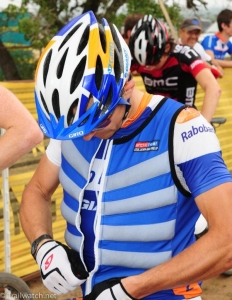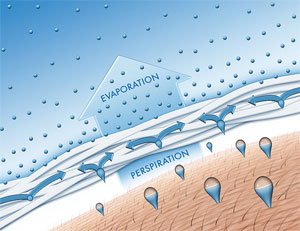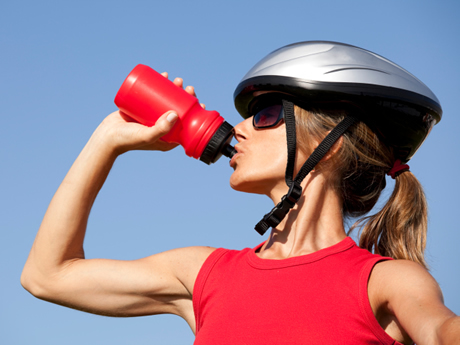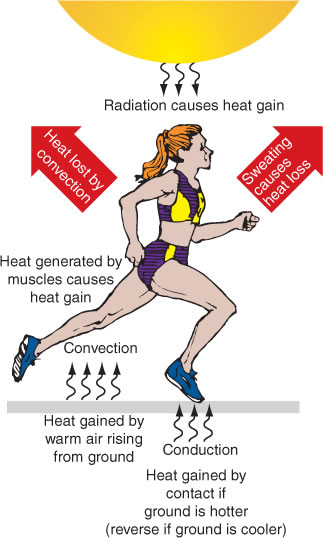The body uses four mechanism for temperature regulation: convection, radiation, conduction, evaporation. Of these, we rely most heavily on evaporation to regulate body temperature through sweat.
Convection for temperature regulation
Convection is defined as: “heat transferred by mass motion of a fluid, such as air or water, when the heated fluid moves away from the source of heat, taking heat energy with it.” For our purposes the source of heat is our body, so convection is heat removed by air or water passing over our body removing the heat as it goes. Convection naturally occurs as the athlete moves, by running, riding etc, through the air, or when a breeze is blowing.
Strategies an athlete can use to support convection as a temperature regulation mechanism
 If our body needs to lose more heat, placing the athlete in front of a fan, and pouring water over the skin are useful strategies the athlete can use to support convection as a temperature regulation mechanism.
If our body needs to lose more heat, placing the athlete in front of a fan, and pouring water over the skin are useful strategies the athlete can use to support convection as a temperature regulation mechanism.
If the athlete’s body is becoming too cold, then this mechanism of heat loss can be slowed by wearing a wind breaker jacket to prevent the wind from contacting the body surface, preserving heat.
Radiation for temperature regulation
Radiation of heat is “the transfer of internal energy in the form of electromagnetic waves – usually infrared”. As the body produces heat, some heat is lost through radiation. This can be linked with the heat of a fire. The heat given off by a fire is largely done through radiation (light is an example of radiation). If you stand in the light of the fire, it is warmer, than if there is something blocking the light. This is because is stops some of the radiated heat from reaching you. The sun also provides heat through radiation. Our bodies, though to a lesser degree than fire, also radiate heat into the environment in order to lose it. However, our bodies will also gain radiated heat if we are performing out in the sun.
Strategies an athlete can use to support radiation as a temperature regulation mechanism
 If the athlete is hot and needs to lose heat, exposing more skin to the environment can help to lose more heath by radiation. However, radiation is one of our bodies least effective mechanisms for temperature regulation.
If the athlete is hot and needs to lose heat, exposing more skin to the environment can help to lose more heath by radiation. However, radiation is one of our bodies least effective mechanisms for temperature regulation.
If the athlete is cold, exposing the athlete to the sun or a warm fire will help to heat the body causing body temperature to rise.
Conduction for temperature regulation
Conduction is “the transfer of heat between two (2) objects in contact with each other”. The heat transfer is always from the hotter object to the cooler one. During exercise, our bodies heat up due to the creation o heat when ATP is turned to ADP and P. If the body is warmer than the bike being ridden, some heat will be lost through conduction. However, if the athlete is cooler than the object, such as running on a hot road, then heat is conducted to the body.
Strategies an athlete can use to support conduction as a temperature regulation mechanism
 When an athlete is hot, conduction can be a great way to lose heat. Exposing the skin and lying down on a cool surface such as a rock, or metal will allow heat to be lost into the cooler object. The most used form of conduction is an ice-vest. Players will frequently wear ice-vests in order to keep their bodies cool. Ice-vests work as heat is conducted from the body into the ice, warming the ice and removing heat from the body. Conduction will occur every time two (2) objects are in contact.
When an athlete is hot, conduction can be a great way to lose heat. Exposing the skin and lying down on a cool surface such as a rock, or metal will allow heat to be lost into the cooler object. The most used form of conduction is an ice-vest. Players will frequently wear ice-vests in order to keep their bodies cool. Ice-vests work as heat is conducted from the body into the ice, warming the ice and removing heat from the body. Conduction will occur every time two (2) objects are in contact.
This can be two players, or a player and a piece of equipment. Some equipment works as a better conductor than others. For example, a metal baseball bat will conduct heat well, while a players leg pads will not.
If a sport requires the athlete to be in constant contact with a good conductor, it is important to keep the conductor at a temperature that will improve the safety of the athlete. For example, motor racing requires the athlete to be in contact with their seat the whole time. If it is a hot day and the conductor is hot, it places the athlete at greater risk, because they will gain more heat from the conducting object.
Evaporation for temperature regulation
 Evaporation is our bodies main mechanism for heat loss. Evaporation is “the transfer of heat from our body, to water (sweat), resulting in the water becoming a vapour and taking the heat away with it”. Our bodies are well designed to sweat in the heat. Trained athletes will even begin to sweat before it is needed because their body knows it will be needed as the athlete continues to move and produce more heat.
Evaporation is our bodies main mechanism for heat loss. Evaporation is “the transfer of heat from our body, to water (sweat), resulting in the water becoming a vapour and taking the heat away with it”. Our bodies are well designed to sweat in the heat. Trained athletes will even begin to sweat before it is needed because their body knows it will be needed as the athlete continues to move and produce more heat.
Each athlete sweats at their own rate. The rate of sweat can be found by weighing the athlete before and after exercise, while measuring the fluid consumed. The sweat rate is the loss of weight in Kg plus the amount of liquid consumed in L divided by the time of exercise in hours. This provides a sweat rate in litres per hour. Many athletes sweat between 1 and 2 L/h.
Evaporation is affected by the humidity of the air. The more humid the air the less effective evaporation is at removing heat. This is because it is harder to convert the sweat into a vapour as the air already has lost of vapour in it. This of it like an aeroplane. If the aeroplane is already mostly full, you cannot add many more people to the aeroplane. So when it is a humid day, the air is already quite full of vapour and not much more can be added.
Strategies an athlete can use to support evaporation as a temperature regulation mechanism
If an athlete is hot evaporation can be increased, by adding water to to the surface of the body. Actions such as pouring water over the body will leave more water on the body to evaporate off, taking the heat with it. Drinking plenty of fluid will also assist the evaporation process as it allows the body to continue to produce sweat without causing dehydration to the athlete.
However, if the athlete is cold and wet, they will lose heat through evaporation. In this case, removing the water with a towel or taking off wet clothes, will help prevent heat lost due to evaporation. Furthermore, you can place a barrier over the wet body to prevent the evaporated water from spreading into the atmosphere. For example,wearing a jumper after getting out of a pool will help trap the water vapour, causing a humid environment under the jumper and preventing the loss of heat through further evaporation.


